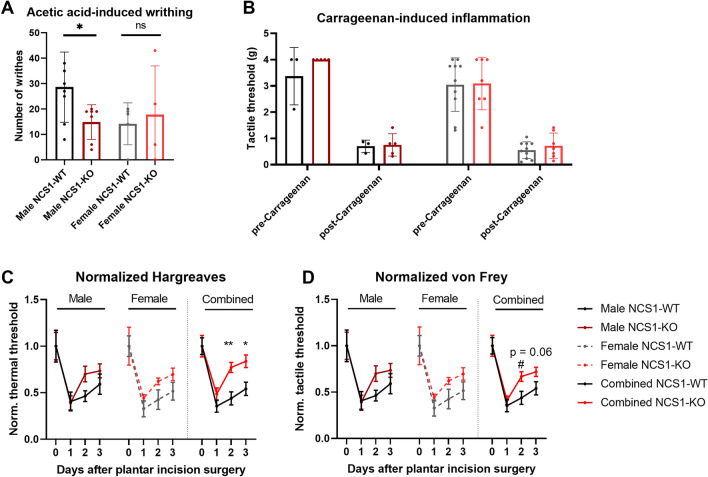Figure 2.
NCS1-WT and -KO mice exhibit differences in pain sensation. (A) Male NCS1-KO mice (n = 7) exhibited fewer writhes compared to -WT controls (n = 8) after dilute acetic-acid injection (unpaired t-test, p = 0.03), whereas female mice (NCS1-KO: n = 4, NCS1-WT: n = 5) showed no difference between genotypes (unpaired t-test, p = 0.7176). (B) No differences were observed between NCS1-KO (male NCS1-KO: n = 5, female NCS1-KO: n = 7) and -WT mice (male NCS1-WT: n = 3, female NCS1-WT: n = 10) in the Carrageenan inflammatory pain assay [2-way ANOVA (male), Factor genotype, p = 0.20; 2-way ANOVA (female), Factor genotype, p = 0.73]. (C) The normalized Hargraves assay shows differences between NCS1-KO (female NCS1-KO: n = 4, male NCS1-KO: n = 6) and -WT mice (female NCS1-WT: n = 8, male NCS1-WT: n = 4) 2 and 3 days after plantar incision surgery (2-way ANOVA, Factor genotype, p = 0.03, followed by multiple comparison test with Sidak’s correction, day 2, p = 0.01, day 3, p = 0.02). (D) The normalized von Frey assay indicates a difference between NCS1-KO (male NCS1-KO: n = 6, female NCS1-KO: n = 4) and -WT (male NCS1-WT: n = 8, female NCS1-KO: n = 4) 2 days after plantar incision surgery (2-way ANOVA, Factor genotype, p = 0.16, followed by multiple comparison test with Sidak’s correction, day 2, p = 0.06). Line graphs show mean ± SEM, bar graphs show mean ± SD.

